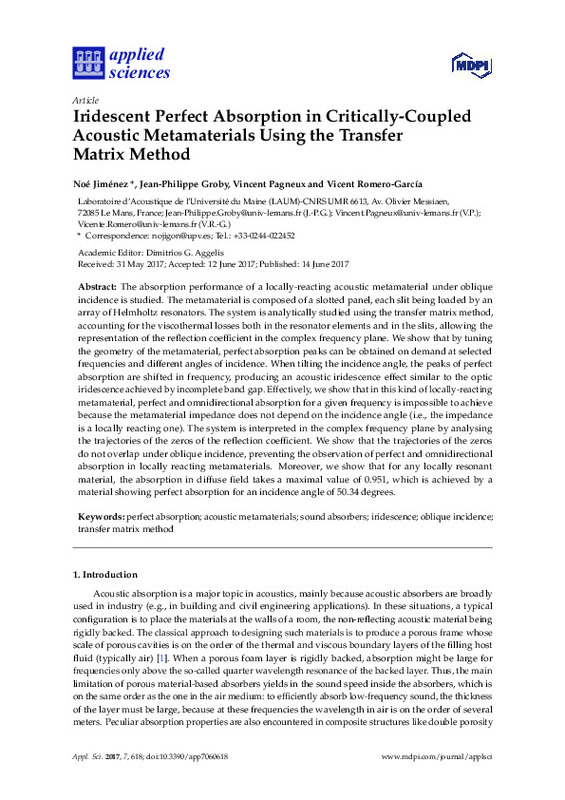JavaScript is disabled for your browser. Some features of this site may not work without it.
Buscar en RiuNet
Listar
Mi cuenta
Estadísticas
Ayuda RiuNet
Admin. UPV
Iridescent Perfect Absorption in Critically-Coupled Acoustic Metamaterials Using the Transfer Matrix Method
Mostrar el registro sencillo del ítem
Ficheros en el ítem
| dc.contributor.author | Jimenez, Noe
|
es_ES |
| dc.contributor.author | Groby, Jean-Philippe
|
es_ES |
| dc.contributor.author | Pagneux, Vincent
|
es_ES |
| dc.contributor.author | Romero García, Vicente
|
es_ES |
| dc.date.accessioned | 2018-03-25T04:09:05Z | |
| dc.date.available | 2018-03-25T04:09:05Z | |
| dc.date.issued | 2017 | es_ES |
| dc.identifier.uri | http://hdl.handle.net/10251/99706 | |
| dc.description.abstract | [EN] The absorption performance of a locally-reacting acoustic metamaterial under oblique incidence is studied. The metamaterial is composed of a slotted panel, each slit being loaded by an array of Helmholtz resonators. The system is analytically studied using the transfer matrix method, accounting for the viscothermal losses both in the resonator elements and in the slits, allowing the representation of the reflection coefficient in the complex frequency plane. We show that by tuning the geometry of the metamaterial, perfect absorption peaks can be obtained on demand at selected frequencies and different angles of incidence. When tilting the incidence angle, the peaks of perfect absorption are shifted in frequency, producing an acoustic iridescence effect similar to the optic iridescence achieved by incomplete band gap. Effectively, we show that in this kind of locally-reacting metamaterial, perfect and omnidirectional absorption for a given frequency is impossible to achieve because the metamaterial impedance does not depend on the incidence angle (i.e., the impedance is a locally reacting one). The system is interpreted in the complex frequency plane by analysing the trajectories of the zeros of the reflection coefficient. We show that the trajectories of the zeros do not overlap under oblique incidence, preventing the observation of perfect and omnidirectional absorption in locally reacting metamaterials. Moreover, we show that for any locally resonant material, the absorption in diffuse field takes a maximal value of 0.951, which is achieved by a material showing perfect absorption for an incidence angle of 50.34 degrees. | es_ES |
| dc.language | Inglés | es_ES |
| dc.publisher | MDPI AG | es_ES |
| dc.relation.ispartof | Applied Sciences (Basel) | es_ES |
| dc.rights | Reconocimiento (by) | es_ES |
| dc.subject | Perfect absorption | es_ES |
| dc.subject | Acoustic metamaterials | es_ES |
| dc.subject | Sound absorbers | es_ES |
| dc.subject | Iridescence | es_ES |
| dc.subject | Oblique incidence | es_ES |
| dc.subject | Transfer matrix method | es_ES |
| dc.subject.classification | FISICA APLICADA | es_ES |
| dc.title | Iridescent Perfect Absorption in Critically-Coupled Acoustic Metamaterials Using the Transfer Matrix Method | es_ES |
| dc.type | Artículo | es_ES |
| dc.identifier.doi | 10.3390/app7060618 | es_ES |
| dc.rights.accessRights | Abierto | es_ES |
| dc.contributor.affiliation | Universitat Politècnica de València. Departamento de Física Aplicada - Departament de Física Aplicada | es_ES |
| dc.description.bibliographicCitation | Jimenez, N.; Groby, J.; Pagneux, V.; Romero García, V. (2017). Iridescent Perfect Absorption in Critically-Coupled Acoustic Metamaterials Using the Transfer Matrix Method. Applied Sciences (Basel). 7(6):1-11. doi:10.3390/app7060618 | es_ES |
| dc.description.accrualMethod | S | es_ES |
| dc.relation.publisherversion | https://doi.org/10.3390/app7060618 | es_ES |
| dc.description.upvformatpinicio | 1 | es_ES |
| dc.description.upvformatpfin | 11 | es_ES |
| dc.type.version | info:eu-repo/semantics/publishedVersion | es_ES |
| dc.description.volume | 7 | es_ES |
| dc.description.issue | 6 | es_ES |
| dc.identifier.eissn | 2076-3417 | es_ES |
| dc.relation.pasarela | S\343313 | es_ES |








